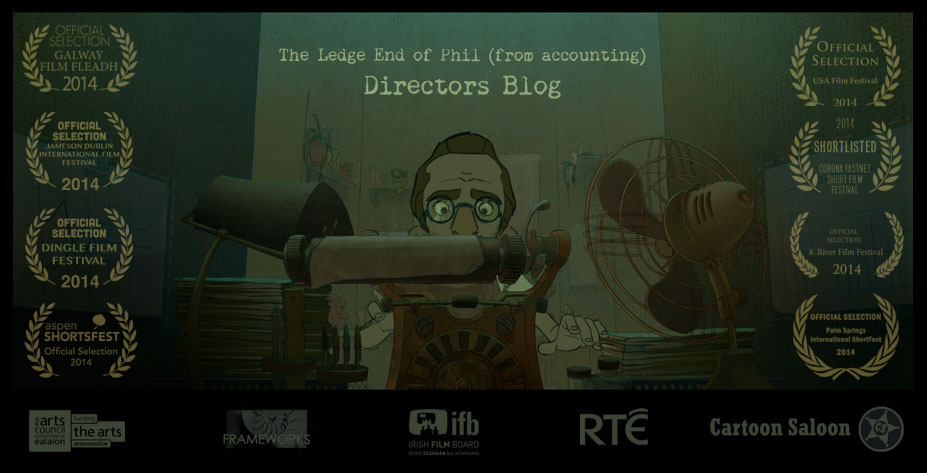F. Scott Fitzgerald said that if you “Begin with an individual, before you know it you find that you have created a type; begin with a type, and you find that you have created–nothing."
When i started to break down
the elements of the story, i realised there are a lot of
features and shorts about office workers out there. I hadn't really
thought about it up until this point but if it was in fact a “clichéd” character, i
wanted to acknowledge it head on.
One major plus is that a cliché presents a character type people feel they recognise or understand at first glance. It works as an immediate shorthand. Understanding the baggage that comes with a preconceived archetype, it's then up to the writer to work with or against the audience's expectations. What was important for me was that i was writing about Phil, a character i found myself connected to in a scenario i wanted to explore.Though Phil is a man whose life revolves around his work, he still had to go home at night. He still had to travel to work every morning. He had a relationship of sorts with the other people in his office, with his parents. He had aspirations of who he wanted to be. Because he never speaks it doesn't mean there isn't a through line of dialogue running in his head. I wrote alot of notes about these parts of his life I've never shown to anyone and i never will.
One major plus is that a cliché presents a character type people feel they recognise or understand at first glance. It works as an immediate shorthand. Understanding the baggage that comes with a preconceived archetype, it's then up to the writer to work with or against the audience's expectations. What was important for me was that i was writing about Phil, a character i found myself connected to in a scenario i wanted to explore.Though Phil is a man whose life revolves around his work, he still had to go home at night. He still had to travel to work every morning. He had a relationship of sorts with the other people in his office, with his parents. He had aspirations of who he wanted to be. Because he never speaks it doesn't mean there isn't a through line of dialogue running in his head. I wrote alot of notes about these parts of his life I've never shown to anyone and i never will.
Something that changed for me on Phil was i found myself writing for a reader for the first time. I have to admit when i write scripts at least the first draft is always a shooting script, i tell the entire story in script format but shot by shot, every camera move, character inflection sound effect in a shot sequence written linearly to pace for editing. Because it's the way i think it's easier for me to write that way, and i tend to leave it with that amount of description. But what i hadn't considered is that for a non production person or script reader it reads like an instruction manual. Luckily for me Nora Twomey (One of the heads of Cartoon Saloon) quickly pointed this out in her notes
“... the primary function of the script at this point is
to entertain the reader enough so that they want to see it realised
on film....don't get too involved in camera description that breaks the flow of action”
I started to work on differentiating between the narrative flow of visuals versus a combination of visuals with a more literary narrative approach.
I mentioned the origin of the name in the last post , I'm pretty sure the name “The Ledge End of Phil” actually comes from a story about my mother reading cinema listings to my father when they were first dating, she announced the "Leg End of Machine Gun Kelly" was playing that night. My father thought it was hilarious and so I heard that story a hundred times growing up. So basically if you think about it, Phil originated from:
Depending on what i'm writing
or working on i generally have a radio, a soundtrack score, and a
film I've seen a thousand times on (something like Jaws, Nightmare
Before Christmas etc) and i switch between these constantly as i work. Depending on whether i need stimulation, distraction or focus. I realise this may sound a little ridiculous, but it doesn't really matter. For me it works. The
paradoxical thing I've learned from studying writers and directors i
admire is they all have wildly different views on the only way to
approach practically everything in their lives. Whether it's editing,
syntax or framing. They all have “The Answer” that says i do it
this way because any other way is madness. Everyone who works with
them says their technique is great and defines their work because of
“The Answer”. But they all make great work. It's important to understand why people choose other methods, but there is no right or
wrong answer. As long as the outcome is (as Hemingway would
put it) “true”.
Any element that
inspires or helps you create, build on it. People don't have
to get your workflow. If you make great work (or even good work) they'll accept it.
In the next post I'll be talking about our trip up to Dublin to pitch Phil to the Irish Film Board!


No comments:
Post a Comment